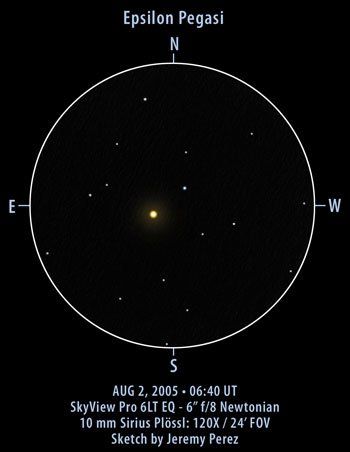Double Star of the Month:
Epsilon Pegasi
AKA: Enif; Pendulum Star; S 789
Position: 21 hr 44.2 min + 9 degrees 52 min 30.0 sec
Due south at 21:07 (BST) on 15 October 2021.
Image credit: Jeremy Perez (http://www.perezmedia.net/beltofvenus)
Used with permission
Epsilon Pegasi is both pretty and has a back story. In this case we are interested in the primary and the C secondary; the B secondary is very dim being only magnitude 12.8. The primary is an easily spotted magnitude 2.4 star and the C star is a dimmer 8.6 which is fairly easily separated as it lies 144 arcseconds from the primary. The main star is a red supergiant of 12 solar masses with the classification K21b, which explains its bright yellow colour. The secondary C is spectral class F8 which implies it is yellowish but it appears blue (or violet) by contrast. This is very similar to the situation with Gamma Delphini (see the DS for September 2021). It appears that this pair was first split by the famous (if irascible) double star observer Sir James South at Passy near Paris – famous at the time for being the residence of Benjamin Franklin during the American War of Independence, but now associated with the Impressionist painters – on 6 November 1824. However it is clear that he was confused between B and C. He described the secondary (presumably C) as being blue. The stars are not physically connected; the primary is 690 light years away whereas C is only 477 light years distant, and hence it is a purely optical double.
The main interest of this double star is the optical illusion first mentioned by Sir John Herschel which gives the star its modern moniker as the pendulum star. C is more or less directly below the primary (if the telescope is a reflector – or a refractor without a diagonal – and has north at the bottom) and if you tap the telescope gently (or move it gently from side to side), the bright primary appears to remain fixed as a result of persistence of vision whereas the dimmer secondary moves with the telescope so it appears to swing like a pendulum. This illusion was mentioned by Rev. Thomas Webb in the 1881 edition of his Celestial Objects for Common Telescopes, but was popularised by Robert Burnham in his Celestial Handbook of 1978, and it was given the name of the pendulum star around this time (although not by Burnham it seems). The older name for this star, Enif, is the Arabic for “nose” as this area was the muzzle of the flying horse in older charts (H.A. Rey by contrast makes this region one of the legs of the horse). Enif lies in a fairly barren region for bright stars so it is easily found. It is more or less on the same level as Altair of the Summer Triangle and lies beneath the easily recognized constellation of Delphinus. To be more exact, draw a line along the top of its neighbour Equuleus (Gamma and Delta Equulei) and follow this line to the left (or west) until you reach a bright star, which is Enif. Right now, it lies directly above Jupiter (but it is some distance above Jupiter).
